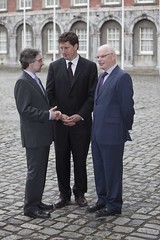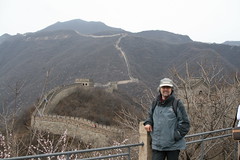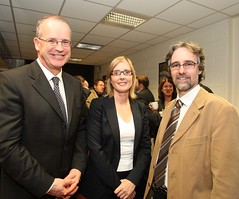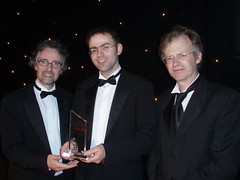13 March 2012
Google Scholar Page
I just enabled my Google Scholar Page: Mícheál Ó Foghlú - Google Scholar Citations.
I had previous enabled by ACM personal profile: Mícheál Ó Foghlú - ACM Author Page.
6 January 2012
Three new PhD Graduates from TSSG at WIT Ceremony
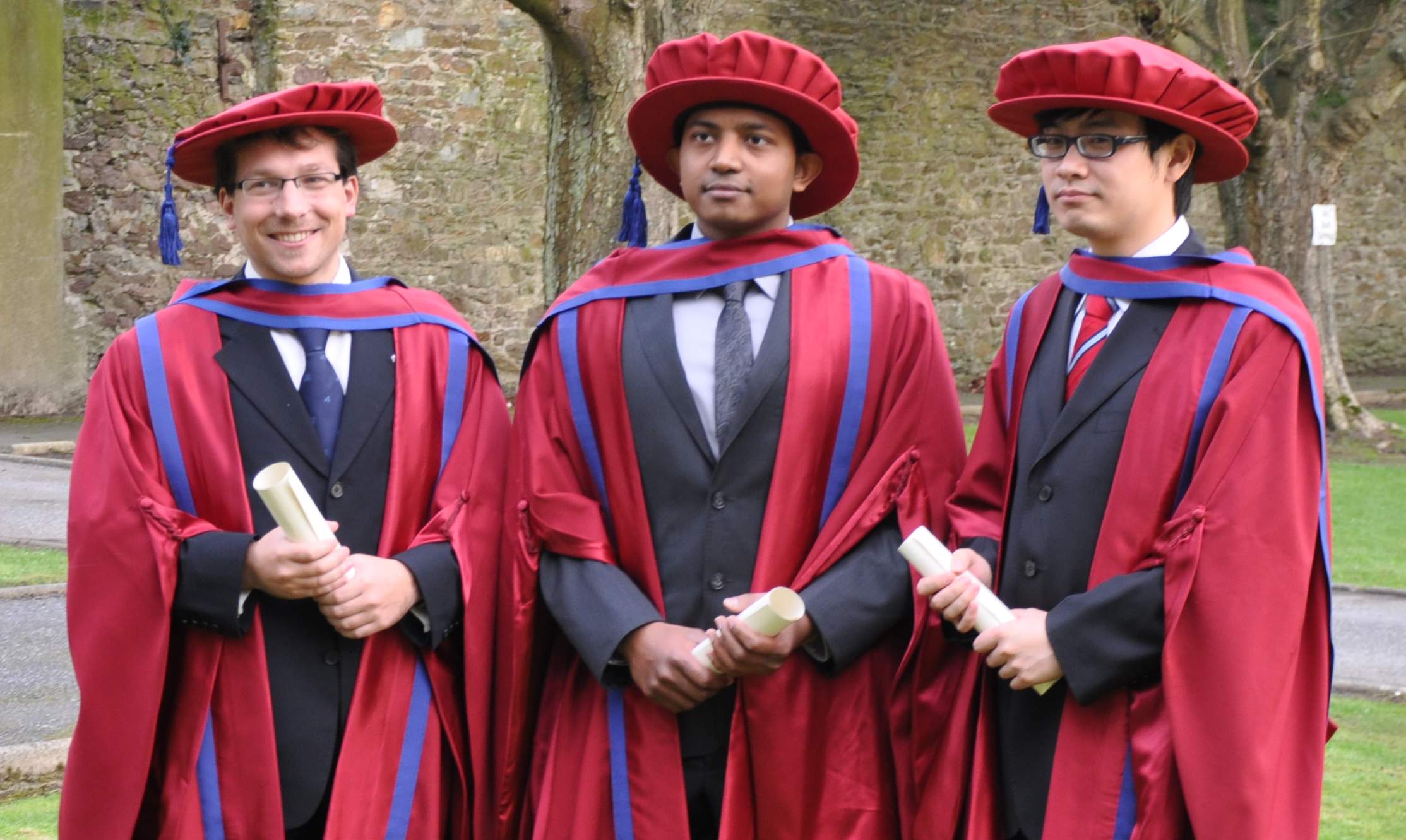
It was my pleasure to attend the graduation ceremony in WIT on Friday 6th January 2012 where three more PhD students graduated from the TSSG. These were (left to right in picture above) Dr Korbinian Frank, Dr Gajaruban Kandavanam and Dr Lei Xu. These join the previous gradutes for a total of eight PhD gradutes from the TSSG to date.
Doctorates represent many years of hard work, comprising persperation and insiration, and I wish all the new graduates all the best.
Of course, I should also mention the supervisors for these students, respectively Dr Tom Pfeifer, Dr Dmitri Botvich and Dr Brendan Jennings pictured with Lei below (with me on the far right, Tom to my left, Dmitri on the far left and Brendan to his right). Dr Sasi Balasubramaniam, not pictured, was a co-supervisor of Gajaruban.
In order for these students to graduate many others in the TSSG contributed to supporting the students, and to the funding that helped create the environment where this research could be done. It is interesting that all of the supervision of these students was carried out out by full-time researchers in the TSSG whose funding came from competive basic research grants (HEA and SFI), so the achievment is definitely one of the students, of the supervisors and of the TSSG in general.
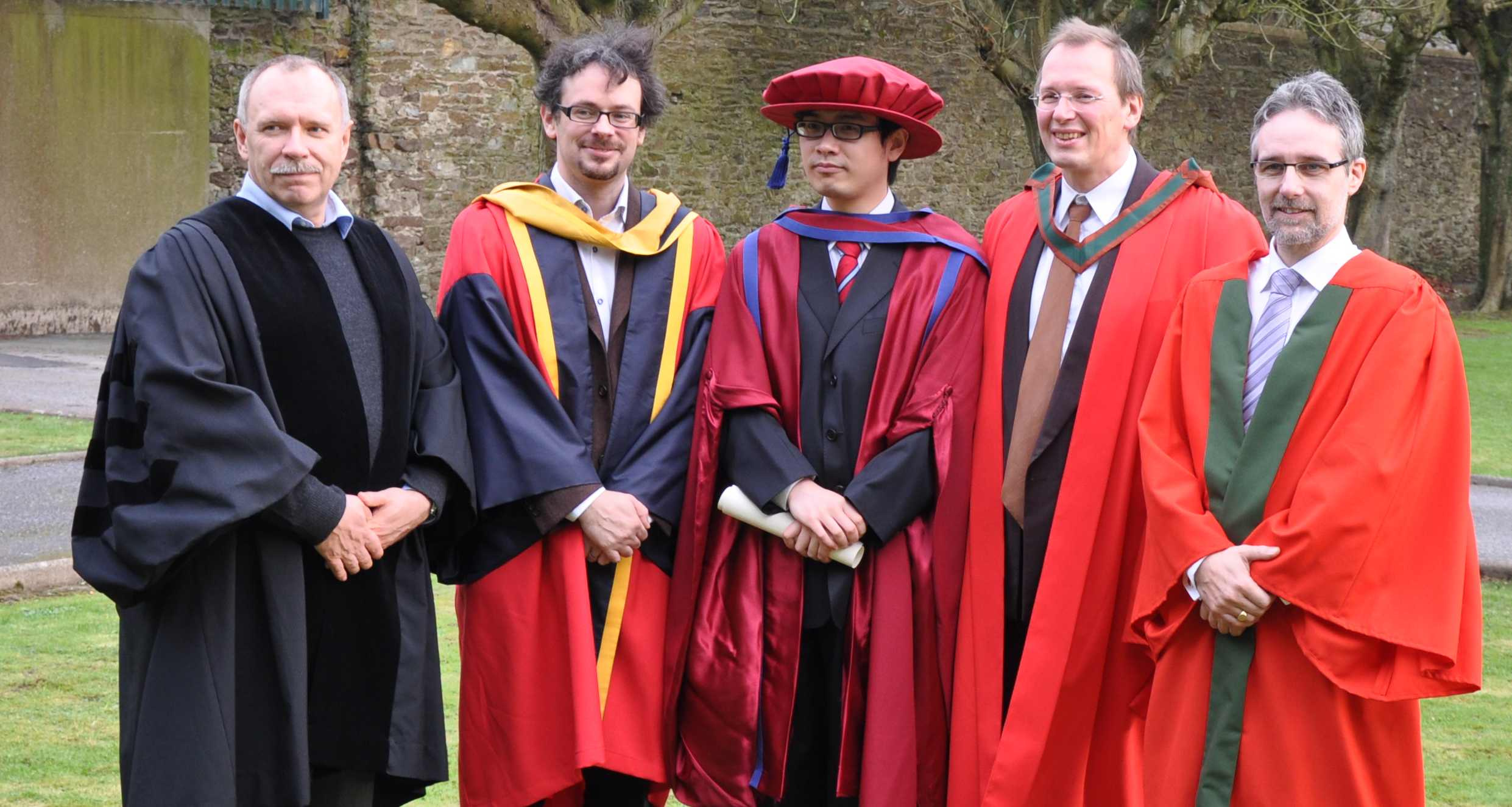
8 June 2011
World IPv6 Day today
Today is World IPv6 Day, organised by the Internet Society (ISOC). Internet Society - World IPv6 Day.
Read the "About IPv6" section of the Irish IPv6 Task Force website if this means nothing to you :-)
Many people are experimenting with turning on IPv6 for the first time, and/or turning off IPv4 to see if the IPv6 infrastructure can cope.
So today is a good day to test your own machine to see how well it can cope with the next generation internet protocol, IPv6: http://www.testipv6.com.
In Ireland there is a good IPv6 readiness site, http://www.ipv6ready.ie, sponsored by the INEX, the Dublin Internet Neutral Exchange.
The Irish IPv6 Task Force has also a website for the day, http://www.ipv6day.ie, the site includes a monitoring tooolset that monitors IPv6 readiness for high profile public and private sector Irish internet sites.
14 April 2011
Science, Engineering and Technology Research Funding Policy in Ireland 1995-2008: A Policy Document Analysis
My thesis on Irish Research Funding Policy, accepted last summer for a doctorate in the University of Sheffield, School of Education, has been published on the University of Sheffield e-thesis website. This site is shared by the Universities of York and Leeds, and so is called White Rose eTheses Online. It has also been published on the Waterford Institute of Technology repository (i.e. where I currently work).
Ó Foghlú, Mícheál (2010) Science, Engineering and Technology Research Funding Policy in Ireland 1995-2008: A Policy Document Analysis, EdD Thesis, University of Sheffield, School of Education. (University of Sheffield PDF, WIT PDF).
Abstract
In the period 1995 to 2008 there has been an increased level of government funding
for research and development in higher education institutions in Ireland.This thesis analyses the evolving theoretical literature on the production of
knowledge, and traces how models of research and innovation have evolved in the
contemporary period. Four models are discussed: (i) linear model, (ii) national
systems of innovation, (iii) mode-2 science, and (iv) triple helix.The thesis presents a detailed analysis of a series of public documents produced
in Ireland in the period, and discusses how each one relates to the theoretical
background. Some of these relationships are explicit, where documents cite key
authors and the models as discussed in the theoretical literature. Some of the
relationships are implicit, where the manner in which the process of research and
development is described implies that certain models are being assumed.The thesis subsequently discusses the results of this analysis, where it seems
that the Irish policy literature is moving away from an engagement with at least
some of these theoretical models, towards a very operationalised implementation
strategy. This is epitomised by the development of the Strategy for Science
Technology and Innovation.The thesis finally makes a number of recommendations for policy makers,
advising the more detailed study and analysis of Ireland's own national system
of innovation, and the prioritisation of the use of research funding to build up
capabilities in identified areas of this system that are weak.
26 January 2011
TSSG's new building has an energy efficient data centre
![]()
The Telecommunications Software and Systems Group (TSSG) at Waterford Institute of Technology has a new energy–efficient data centre to support its network-based research projects in the area of telecommunications networking.
Right now, TSSG is working on an average of 40 to 50 research and development projects. It has been recognised as one of the top 10 European institutes driving ‘future internet’ research.
Kedington Group has designed the centre at TSSG, which has an IT power load of 300Kw, with some cabinets engineered to house 30kw of IT equipment. It deployed Rittal LCP technology, which uses chilled water (at 15°C) and will provide free cooling 72pc of the time, for the new data centre.
14 July 2010
Horn blogs on Irish Innovation Fund
It was refreshing to read that one of the outputs of Ireland's recent Innovation Task Force Report has been the establishment of an Innovation Fund RTE, Irish Times, Bloomberg.
Chris Horn explains the context in his excellent blog post: Innovation Fund: Go, Ireland, Go ォ Chrisjhorn's Blog
For the TSSG's view of research and innovation in Ireland see our submission to the Task Force, the page also has links to the resulting Task Force Report.
6 July 2010
Public Service Review: Science & Technology
The TSSG has published a series of editorials in Public Service review: Science & Technology. This lists them all with links to the on-line version.
- What Next for the Net? PSR: ST Issue 7 (pages 90--01)
- A Telecomms Transformation: IMS and Next Generation Networks PSR: ST Issue 6 (pages 142--143)
- The Dynamic Approach (Research and Innovation in Ireland) PSR: ST Issue 5 (pages 72--73)
- The Telecommunications Software & Systems Group: shaping future communications networks and services PSR: ST Issue 4 (pages 84--85)
- Advertisement PSR: ST Issue 4 (page 1)
26 May 2010
A busy calendar
The TSSG has been organising so many events over past 3 months that its been hard to keep up. Most of these events have had over 100 people from Irish academia and industry, engaging with various aspects of our activity set in the TSSG.
- NGN Test Centre (Dublin)
- Irish IPv6 Summit (Dublin)
- FeedHenry Developer Day (Dublin)
- FAME/CTVR LTE Event (Dublin)
- 3CS Industry Consultation Workshop (Waterford)
In addition we've taken part in a number of critical events, including an Enterprise Ireland information day on the Future Internet PPP call in EU FP7 (c.f. White Paper on FI PPP), as well as taking part locally in a WIT Research Day last Monday. The TSSG usually try and have 2-3 events in Dublin per year, but 2010 looks like being a bumper year for event organisation.
19 May 2010
Irish IPv6 Summit 2010 - a Great Success
On Wed 19th May 2010 we held the 2nd successful Irish IPv6 Summit in Dublin Castle with an impressive array of international speakers, and a registered audience of over 100 delegates.Pictured to the right are myself, Eamon Ryan TD (Minister of Communications), Roger O'Connor (Department of Communications, Energy and Natural Resources).
The event was streamed live over IPv4 and IPv6, and edited videos of the presentations will be available shortly. The slides for each presentation have been posted and are available now. The event received some good press coverage, including local radio coverage by WLRFM and press coverage by Silicon Republic.
We now look forward to further engagement with Irish industry and the public sector to help promote IPv6 in Ireland. Contact me if you would like to get involved.
6 May 2010
Public Service Review: Science & Technology
The TSSG has published a series of editorials in Public Service review: Science & Technology. This lists them all with links to the on-line version.
- What Next for the Net? PSR: ST Issue 7 (pages 90--01)
- A Telecomms Transformation: IMS and Next Generation Networks PSR: ST Issue 6 (pages 142--143)
- The Dynamic Approach (Research and Innovation in Ireland) PSR: ST Issue 5 (pages 72--73)
- The Telecommunications Software & Systems Group: shaping future communications networks and services PSR: ST Issue 4 (pages 84--85)
- Advertisement PSR: ST Issue 4 (page 1)
5 May 2010
Feedhenry
TSSG - Telecommunications Software & Systems Group: FeedHenry, a TSSG Spin- Out Success!
Waterford, Tuesday May 5th 2010. The Telecommunication Software & Systems Group (TSSG) located at the Waterford Institute of Technology (WIT) is delighted to announce the official spin-off of FeedHenry, an award-winning software firm.
Dr. Willie Donnelly, Director of the TSSG and Head of Research and Innovation at Waterford Institute of Technology said, “FeedHenry is another successful commercialisation result from TSSG’s purpose-built commercial arm, the Centre for Converged Services (3CS). We believe that the application of technology and the exploitation of research is a key driver for Ireland’s economic growth. Leading research institutions like TSSG have a crucial role to play in en¬hancing Ireland’s economic competitiveness,” he said.
Read the full article featured in Silicon Republic here
26 April 2010
Extended China Visit
Well, trust me to be on the longest trip away I had been on for about 6 months when disaster struck European airspace with volcanic ash meaning lots of flights were cancelled. So ended up being away from home for 2 weeks instead of 1 week.I was with some WIT colleagues visiting Dalian in north east China (see out TSSG weblog entry for details).
I came back to Beijing to get my onward flight to Dublin via Abu Dhabi with Etihad Airways, and I was told at midnight on Saturday the 17th April that my flight was cancelled, and that was not allowed to even go on the first leg of the journey to Abu Dhabi (despite having a boarding card generated via online check-in), and that my payment had been refunded and I was on my own. This is not what I expect as a customer when this type of incident happens, I expect some help and support from the airline. So much for customer service. So there I was on my own in a strange city with nowhere to stay and no knowledge of the local language spoken or written (I'd only been in Beijing the previous Tuesday for a transfer to another flight).
Luckily, I managed to get myself a booking at an excellent hotel in the city centre, the Park Plaza (very near the shopping area of Wangfujing and walking distance to the Forbidden City), to get a taxi to take me there, and I spent a week waiting for the WIT travel agent, FCM Travel Ireland, to be able to come up with an alternative way home. Eventually I secured a full-price (just shy of €2k) flight home with Lufthansa via Frankfurt the following Saturday. Quite expensive given my original return was only just over €1k.
Well I worked out a schedule where I would get up a bit late, do some touristy things, have an early dinner around 6pm local time, and then work in the evening when the timezone overlapped with home (4pm local time as 9am in Ireland). This has meant that haven't come back to huge email backlog, though obviously I do have lot of meetings to catch up on (I get around 100 per day, many of which do actually require responses).
I really enjoyed the opportunity to see Beijing, taking in the Forbidden City, the Great Wall (at Mutianyu) and some other cool sights. But I really missed being away from my family. I was really glad to touch down in Frankfurt in the EU27 on Saturday afternoon, and then in Dublin a few hours later.
The photo shows me at the Great Wall, Mutianyu section, which was the highlight of the trip, from a tourist perspective. Equally impressive was the evidence of investment and development in China both in Dalian and in Beijing. You certainly get a feel for China as a happening place, as so many people are saying. I really hope China can figure out how to share its wealth among all its 1.3 billion people, and help everyone, not just a privileged few. Bust I guess I should focus on putting our own house in order in Ireland first, where we've let the wealth gap extend too much during the boom years.
I will have to think long and hard before flying Etihad Airways again -- they did nothing to help me, not even honouring my valid ticket with them for the first leg of my journey home! Buyer beware.
A big thank you to FCM Travel Ireland and to Lufthansa for getting me home safely.
25 April 2010
Irish IPv6 Summit (Wed 19th May 2010) - Registration OPEN

Registration is now open for the Irish IPv6 Summit 2010, that will be held in Dublin Castle on Wednesday 19th May 2010.
10 March 2010
NGN Test Centre Launch
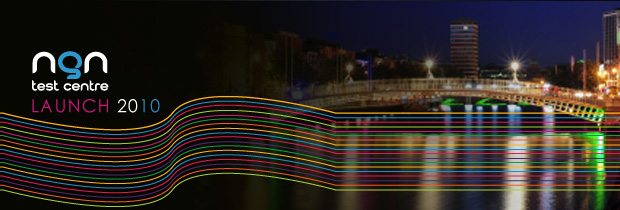
The TSSG is Next Generation Network (NGN) Test Centre launch event in the Guinness Storehouse in Dublin was held on Wednesday 10th March 2010. NGN Test Centre.
Speakers included: Willie Donnelly (TSSG), Ulf Olsson (Ericsson), Shane Dempsey (NGN Test Centre), Anastasius Gavras (Eurescom), Ioannis Fikouras (Ericsson Sweden), Philip Sharpe (ISIN, Danu Technologies), Brendan Kearns (Eircom), Cathal McGloin (FeedHenry), and Catherine Mulligan (Ericsson).
A lively panel discussion was introduced and chaired by Chris Horn; I partcipated on the panel.
- Main website NGN Test Centre
- Photos from the launch event: Flickr
- Slides from the launch event: Slideshare
- Search for hashtag on Twitter #ngntest
9 March 2010
TSSG/FeedHenry at CTIA Wireless 2010

The TSSG will have a strong presence at CTIA Wireless event in the USA the week of the 22nd March 2010. One of our spin-out companies, FeedHenry, will be on the Enterprise Ireland sponsored Ireland Pavilion. Ironically, although the TSSG have been at this event every year for the past 5 years, this is the first time we've been part of the Ireland Pavilion. In previous years we've been guests on the Oracle stand or similraly hosted by other companies.
About FeedHenry:
FeedHenry is the leading innovator in pay-as-you-go cloud solutions for building and deploying cross-platform business and telecoms apps that will run natively on all smartphones, social media sites and browser start-pages from a single code base. We specialise in the development of sophisticated business and telecoms apps, that need to operate across mobile and social media channels, and which require business logic and storage in the cloud, secure integration with existing IT and telecoms systems and delivered to our customers as a complete end-to-end solution with full app lifecycle management and analytics.
About FeedHenry at CTIA Wireless on Ireland Pavilion
CTIA Wireless
March 23rd to 25th 2010, Las Vegas
Ireland Pavilion, Central Hall, C3, booth 1727
About CTIA Wireless
One of the Largest Technology Events in the World!
The International CTIA WIRELESS® show represents a $1 trillion global marketplace that brings together wireless and converged communications, wireless broadband, applications, mobile web and data.
For 25 years, International CTIA WIRELESS® has been THE premier marketplace for all things wireless. Don't miss 2010—guaranteed to be another crucial and groundbreaking event for the industry. Join us for the next era of Mobile Life!
26 February 2010
IET Lecture (Thu 26th Feb 2010)
I gave this talk to the IET on Thu 26th Feb 2010.
It gives an overview of the TSSG (Telecommunications Software & Systems Group). The focus is on the unique model of balancing basic research, applied research and commercialisation activity (roughloy equally) in a research centre in Ireland.
The next part was a call to arms to migrate to IPv6, giving the historical context of IPv4 depletion.
Finally a note was made of the TSSG's progress towards IPv6 deployment, and of our research activity since 199 in various research themes linked to IPv6, particularly SHIM6.
24 February 2010
TSSG hosts NGN Testbed Launch: Wed 10th Mar 2010 - Guinness Storehouse, Dublin

The TSSG is happy to announce that it is organising a launch event for its Next Generation Network (NGN) Testbed in the Guinness Storehouse in Dublin on Wednesday 10th March 2010. This all day event, starting at 9:00am. Register Here.
Speakers include: Willie Donnelly (TSSG), Ulf Olsson (Ericsson), Shane Dempsey (NGN Test Centre), Anastasius Gavras (Eurescom), Ioannis Fikouras (Ericsson Sweden), Philip Sharpe (ISIN, Danu Technologies), Brendan Kearns (Eircom), Cathal McGloin (FeedHenry), and Catherine Mulligan (Ericsson).
Panel discussion introduced and chaired by Chris Horn.
19 February 2010
TSSG at Mobile World Congress

Mobile World Congress, organised by the GSMA, is the biggest annual conference for those interested in mobile telephony in Europe. As usual the TSSG have an active presence at this trade show.
This year one of the TSSG's spin-in companies, GoMoNews, has been there this week in force covering the event, and organising one the main social mixer events on everyone's calendar, where more than 400 showed up to exchange formal and informal news on mobile technologies. Sinead Quealy has just returned from the event and the highligt for her was Stephen Fry presenting the GSMA awards on Tuesday afternoon.
The other main TSSG presence has been via our spin-out company FeedHenry, that has a demonstration hsoted on the Oracle stand. Richard Roger has also returned to base, and the highlight for him was meeting the BBC.
Next month CTIA in Las Vegas 23rd-25th March 2010 will be a similar event for the North American market, and anticipate a strong TSSG presence there as well.
3 February 2010
Minister Cullen tuns sod on new TSSG Research Building

Last Friday we had Minister Cullen visit the TSSG to turn the sod on our new TSSG Research Building, funded by HEA PRTLI Cycle 4 capital programme, with matched funding from Waterford Institute of Technology. See the TSSG press release (copied below).
It is important to mention that the key people behind the original proposal were Willie Donnelly (the PI), myself, Brendan Jennings and Sven van der Meer. Of course like any large proposal this was team effort with many others contributing as well, and more subtly with the potential success based on the reputation of the TSSG that draws on an even wider set of people and achievements. The funding was won back in 2007 and this comprised a recurrent element, that funds the FutureComm project, and the capital element, that funds this new building.
As it happens we are conducting an internal mid-way review of the FutureComm project today in the Digital Hub. The key people in terms of actually delivering this work programme are Dmitri Botvich, who coordinates our research activity and manages the team, and Tom Pfeifer, who contributes his own expertise and acts as the logistics and support coordinator.
So these two events have given me the opportunity for reflection, and I am generally reminded of the good job we are doing, and of the importance of capturing this and promoting it publicly. This is actually very difficult given the complex nature of the inter-relationships between our various activities (126 funded projects in the period 1996-2010 to date, with nearly 40 active in 2010, and that doesn't include the 52 smaller Enterprise Ireland Innovation Vouchers we have done).
Martin Cullen TD, Minister for Arts, Sport & Tourism, turned the first sod today (Fri, Jan 29) on a new 1,056m² four-storey research building at Waterford Institute of Technology’s West Campus at Carriganore.Funded by the Higher Education Authority (HEA) under the Programme for Research in Third Level Institutions (PRTLI), the €5m development designed by Devereux Architects is being built by BAM Construction and represents the next phase of expansion at the campus where much of the Institute’s fourth level research, development and innovation activity is now concentrated.
Set for completion in 2011, the new building will be clearly visible from the Waterford City Bypass and is being developed to the northwest of the ArcLabs Research and Innovation Centre. With a maritime design, it will overlook the nearby River Suir and accommodate offices and meeting rooms for postgraduate and postdoctoral researchers as well as general office and laboratory space.
Speaking as work commenced on site, Minister Cullen said: “Continued investment in Ireland’s research infrastructure is a central part of our push towards delivering on the ‘Smart Economy’ agenda that offers the strongest prospects for economic recovery and a return to sustainable growth.
“Going back to my own time as Minister of State at the Department of Finance a decade ago when the land-bank here at Carriganore was acquired for Waterford Institute of Technology, I had always been convinced that the Institute would have – as it now does - one of the finest higher education campuses in the country.
“Following on from the refurbishment of Carriganore House, the development of ArcLabs and the National Biodiversity Data Centre, this latest phase of development marks another milestone in the rollout of the terrific vision that exists for this location where excellent sports facilities are also nearing completion. The West Campus is, of course, more accessible than ever to the entire region since the opening in October of the N25 Waterford City Bypass.”
Redmond O’Donoghue, Chairman, Waterford Institute of Technology, added: “In what is our 40th year, the Institute and the wider community in the southeast can be justly proud of the great strides that have been made by researchers here. This latest significant addition to our West Campus will allow that work to continue to grow in scope and depth.
“It is vital that we maintain investment in the research that will deliver the employment opportunities of tomorrow. The additional space to be provided by this latest campus expansion will allow further growth of our Telecommunications Software Systems Group (TSSG) which has won €40m in national and international research funding for 85 projects over the last five years alone. Specifically, the building will facilitate TSSG work on globally significant HEA-funded research where they are partnering with NUI Maynooth and University of Limerick on the ‘Future Internet’.”
Dr Willie Donnelly, Head of Research, Waterford Institute of Technology and director and< co-founder of TSSG, said: “Our research has enabled us to successfully create a mobile services cluster of high potential start-ups where almost 200 sustainable direct and indirect jobs have been created.
“Our research team continues to successfully compete for funding at a national and international level with the additional facilities now being provided with HEA support set to allow us grow further in the years ahead. As well as having a considerable economic impact for the southeast and ‘Ireland Inc’, TSSG research outputs will also increasingly generate products and services that benefit end users in society more widely.”
The project team for the new building also includes JODA Engineering Consultants; Michael Punch & Partners Consulting Engineers and Brendan Murray & Associates Quantity Surveyors.
20 January 2010
Video Interview with me, Digital Hub TV
On 3rd December 2009 when I was attending the Irish Future Internet Forum in the Digital Hub in Dublin, I was interviewed by the Digital Hub TV. Here is the edited interview, you can also find it here: TSSG Interiew.
26 November 2009
IdeaGen hosted by ArcLabs (TSSG) on Thursday 2nd December 2009 (5pm-7pm)
I have written some background notes on the topics discussed at IDEAGEN on 15th October 1009 in the TSSG, WIT. There is a follow-up event (aimed at for those who attended the first session) on the evening of Wed 2nd December 2009, so these notes could help kick-start some discussions and brain storming. That could be useful notes for those not familiar with the topics, or provocative for those that are.... I just spent 2h or so doing it, so it is not a very studied piece of academic writing, but a set of notes and pointers.
23 November 2009
Irish Future Internet Forum
Miguel Ponce de Leon: Irish Future Internet Forum 2009
Irish Future Internet Forum will be on in the Dublin Digital Hub on 3rd December 2009, free registration.
See you there.
21 October 2009
Ideagen Roadshow - Photos Available
Enterprise Ireland have posted some photographs on Flicker of the Ideagen event hosted in ArcLabs on Thu 15th Oct 2009. This one shows Pat Byrne (Enterprise Ireland), Mary McEvoy (Enterprise Ireland) and myself.Flickr photos of the event: http://www.flickr.com/photos/ideagen
14 October 2009
EI Big Ideas Showcase 2009
RTE.ie Media Player: Six One News 13 October 2009
TSSG had 4 projects/companies featured at Enterprise Ireland's Big Ideas Showcase, making us the most prominant ICT centre displaying at the show.
- IMS-ARCS (preparing Ireland's indistry for IP-based IMS telecommunications software services)
- Zolk C (next generation mobile solutions for heritage sites)
- Feedhenry (flexible standard-scompliant widget platform for dynamic site content)
- 3CS (Enterprise Ireland's ARE centre that underpins the commercial division of the TSSG)
In the RTE news clip from, yesterday's 6 o'clock news, our stand features (you can see 3CS, IMS-ARCS and Zolk C stands) along with Deirdre Morrissey (TSSG Marketing Manager) and Joe O'Reilly (of Raser/FeedHenry). Unfortunately our interviews didn't make the final cut.
13 October 2009
IdeaGen hosted by ArcLabs (TSSG) on Thursday 15th October 2009 (5pm-9pm)

In 2001 the TSSG made the decision to co-locate with the SEEPP, WIT's programme to support new entrepreneurs. The resulting centre was branded as the "WIT Research & Innovation Centre". It was formally opened by the then Tánaiste and Minister for Enterprise, Mary Harney. This plan to co-locate WIT's leading R&D activity with its leading business and entrepreneurial support ecosystem set out our stall in terms of the importance of the links between research and industry, and of indigenous SMEs in particular. In 2006 the then Taoiseach, Bertie Aherne, formally opened the integrated ArcLabs centre. This centre combined the TSSG, the SEEPP but also a number of other services, most importantly an incubation centre for new companies, all under the one roof. Since then many TSSG companies have availed of the services provided by the rich support ecosystem.
The TSSG has grown and now has won €60 Million in R&D funding, bringing in the funding to build the the existing TSSG/ArcLabs building (note this was a combination of HEA funding for the TSSG and Enterprise Ireland funding for an Incubation Centre), and a new TSSG building that will be completed by September 2010, and creating 150 high quality jobs within the TSSG itself, funded by over 125 research projects won through competitive processes. True to its vision of a balanced ecosystem of R&D the TSSG's funding has been a third basic research (funded by SFI and HEA), a third applied research (funded by EU FP4-FP7), and a third pre-product development (funded by Enterprise Ireland). In addition the TSSG has created fourteen spin-out and spin-in companies (c.f. TSSG Companies), creating a further 60 jobs in the region. The TSSG has learned a lot about the difficulties involved in trying to meet all these different requirements from one integrated research centre. We have published our views of how Ireland should continue to support research and innovation in our submission to the Irish Innovation Task Force.
Therefore the TSSG welcomes the opportunity to support IdeaGen - an event organised by Enterprise Ireland that seeks to foster further links between research and industry in the region - on Thursday 15th October 2009 (5pm-9pm) (expression of interest). I have been invited to speak at the event, as well as participate, and I have published my slides on Mícheál Ó Foghlú's Presentation to IdeaGen on the TSSG and ArcLabs.
My message is that Waterford Institute of Technology (WIT), the TSSG, and the other elements that make up the research and innovation ecosystem within ArcLabs, have had a vision for proactively linking research and industry that formally dates back to the opening of our first integrated centre in 2001. We have built a real culture of innovation within the TSSG that combines world class research with real engagement with industry. We welcome collaboration with anyone who seeks to promote the same vision.
Update 2009-10-13 - IdeaGen interact with the social network
Follow IdeaGen on social betworking tools:
12 October 2009
TSSG Publications - New Look on Website
I have recently updated the way the TSSG website displays its publications. The main website that links to these new views of the publications database is TSSG Publications. What's included is an auto-generated listing of all academic publications both by calendar year (in reverse order), and by academic year (in reverse order - we need this for our internal reporting). More interesting to external users is the simple dynamic search facility: TSSG Publications Search.
To do this has involved a few steps, and is the culmination of just over a year of thinking and planning:
- We moved from a proprietary Reference Manager database to using BibTeX;
- We standardised on JabRef to edit the BibTeX and keep it consistent and legal;
- We standardised on UTF-8 as the character set;
- We discussed an implemented a small additional set of tags to capture other useful information not there by default in BibTeX;
- I developed an automation script to synchronise to the latest version of the database (i.e. copy from version control document repository to the webserver);
- I developed a Perl library to handle the creation of suitable HTML format for the different types of BibTeX entries that are possible (basically a big switch statement calling a number of procedures to handle different cases;
- I developed two scripts to run each morning (on the updated source file) and produce the HTML sorted by calendar year and by academic year;
- I developed a preprocessing script to parse the BibTeX and produce some optimised hash data structures for use in the search tool;
- I developed a CGI search tool to find an entry matching a regular expression search, and then display it by calling the HTML library.
There's still lots more to do to auto-generate publications lists for people, for projects, and for academic themes. I'd also like to create automated checks that email the identified author notifying them of missing data and incomplete entries. Most importantly I want to implement the tag we have that links to the PDF download in the WIT Institutional Repository, and I want to try and get the majority of entries to have this field, then I can create the link in the on-line listings, and make it easier for people to find our papers, and read them.
The main drivers I had for this process were to (a) make it easier to automatically keep the website up-to-date; (b) make it easier to generate necessary publications metrics and details for various reports; (c) make it easier for people to find and read the papers we have published. The new system is a good improvement in most of these, and the PDF links should really help with the last point.
18 September 2009
TSSG Innovation Model
The Irish Innovation Task Force has called for submissions from interested parties. In response to this request the TSSG has revised an earlier document of its innovation model, and published this as a contribution to the debate. The TSSG has formally submitted the Executive Summary and the Recommendations from this report to the Innovation Task Force.
Balancing the Basic, Applied and Commercial R&D in Higher Education research in Ireland:
Building a Flexible and Sustainable National Innovation System in an Open Economy
11 September 2009
Interview on WLR FM local radio: Enterprise Ireland funding success €1.7M
The TSSG has had some really great recent success with Enterprise Ireland research funding. The full press release, published Friday 11th September 2009, is on the TSSG website.
Based on this the local radio station in Waterford, WLR FM, contacted me and I did an interview with Mark Power on Friday morning, and it was broadcast on the Friday lunchtime news; I've just uploaded the MP3 Interview WLR FM Fri 2009-09-11 (I've backdated this post to Friday 11th Sep 2009 for ease of reference).
This was a public announcement of a process that dated back to the first half of this year, in fact I am just signinging off on our latestest bactch of proposals going into the next round of Enterprise Ireland CF-TD and PoC funding. The news was that the TSSG/3CS brought in €1.7M in funding in the last Enterprise Ireland round of research funding, with funding for 7 new projects: 3 CF-TDs (larger projects aimed at developing commercial grade software implementations of a research idea), and 4 PoCs (smaller projects aimed at proving whether a concept is feasible by develping a prototype and a market analysis). The TSSG employs 150 people funded by HEA, SFI, EU FP7 and Enterprise Ireland funding programmes. We have a track record of 120 projects and €60M in funding. Our second building is now being constructed in WIT's West Campus in Carriganore.
Well done to everyone who continually works so hard on the proposals that make the TSSG possible. If we didn't bring in the funding to fund our existence, nothing else would be possible.
16 August 2009
Does Ireland need independent Research Institutions?
I have been wondering for some time now whether what Ireland needs is to foster Research Institutes (RIs), that are co-funded by public funding and by industry, and independent of universities (or other Higher Level Institutions).
The idea of the RIs is that they would employ people who had a focus on building successful research outputs that could be used by industry, rather than trying to balance traditional academic goals with this aim, and instead of only employing post-doctoral researchers and PhD students, as pretty much all Irish research centres do today. Thus the RIs could act as a real bridge between academia and industry, acting as a cultural bridge as well as a new place for applied/industry-focused research to take place. I feel strongly that academic faculty, post-doctoral researchers and research students (who make up nearly 100% of the work force employed by the Irish research funding system funded by the HEA, SFI and Enterprise Ireland), will always place a higher priority on the academic issues, such as academic publication, and doing what is needed to get a PhD, rather than on the industrial linkages. If you really want industry linkage to be the main driver and the primary focus, new structures and institutions might be required. If RIs depended on industry for 25% of their funding initially, perhaps 50% after 5 years, then they would be forced to place an equal weighting on the applied research outputs that were of value to the industry that was contributing. Chris Horn has commented on my suggestion (via twitter tagged #itaskforce) that this could well be the problem, getting industry to fund part or all of such enterprises would never be easy, and especially not in the current economic climate; yet relying on public funding is a recipe for longer term failure, as such an RI would be likely to eventually merely replicate the pure academic culture of the existing system.
I am certainly not the first to make this observation about the Irish research and innovation setup. Cogan and McDevitt alude to the defict here:
“The country missed out on institutions such as technological universities and industry laboratories that are a feature of the industrial landscape in most European countries. In addition, Ireland’s chosen path to industrialisation, i.e. following the FDI route, masked until very recently this deficiency in the research infrastructure, and in the intermediaries that help bridge the gap between enterprise and the research base."
(Cogan and McDevitt, 2003, p. 27)
Of course, I have huge respect for my academic colleagues, and their academic work, and indeed there are some very good success stories of successful industrialisation from the existing investments that have been made in Ireland. My point is a structural one, not a criticism of any individuals or existing research centres. Also, the argument I am making is not an argument for not funding good basic academic research as well as good industrially relevant research. The argument is really about all the pieces that have to be in place for a "National System of Innovation" (NSI) to function properly, the theory of NSI being heavily promoted in the 1990s in Ireland when the increased R&D expenditure was proposed, but has been much less studied since that investment has started to be made (from the late 1990s with HEA PRTLI and from early 2000s with SFI, and in the general raising of the levels of funding given out by Enterprise Ireland for academic-industry linked research).
Perhaps the best example of Research Institutes of the type I envisage are in Europe, such as the Fraunhofer Institutes in Germany, e.g. FhG FOKUS in Berlin that we work very closely with in the TSSG. They are required to raise 50% of their funding directly from industry, and get the remainder from the German federal and state coffers, and from EU research project funding - so we are partners with them in many EU funded projects. FOKUS is famous for helping foster innovations such as MP3 and SIP (that underlies most of the Voice over IP world).
What we're trying to do in the TSSG, in effect, is to build such a group inside a Higher Educational Institution (HEI), Waterford Institute of Technology (WIT). We are almost unique in Ireland in being given the freedom to employ non post-doctoral researchers as our primary research staff - our pure academically focused staff are in a minority. We have around 150 staff, 20 of whom are full time PhD students, 14 of whom are post-doctoral research fellows, 4 of whom are full-time faculty, and the rest are various other forms of professionals - software developers, project managers, and other types of researchers (who don't necessarily have a PhD). We also have some administrative staff, and some technical support staff, but these add up to just another 10 people as a maximum. Our argument is that to make an impact in ICT (Information Communications Technologies), what you need are good programmers who can produce high quality code that actually has an economic value in itself - the code base can then form part of the licences granted to industrial partners to exploit these results, whether these be spinout or spin-in companies, or other external companies. Thus our argument has been, since we were founded by Willie Donnelly in 1996, that we should have a balance of a critical mass of sustainable funded research programmes that are (i) basic research programmes - traditional academic research (ii) applied research programmes - focused on industrial problems and industrial partners and on building working prototype solutions and (iii) commercialisation activities - trying to create economic value based on the outputs of the other two areas. We have achieved the balance in that (i) is funded by HEA PRTLI and SFI, (ii) is funded by EU FP4, 5, 6 and 7 and (iii) is funded by Enterprise Ireland. We've brought in around €60M over the past 13 years, most of it in the past 5 years (TSSG Projects). We've launched 13 spin-in and spin-out companies since 2000, most in the past 5 years, employing 55 additional staff (TSSG Companies).
This article is my own personal opinion, and may not be officially endorsed by the TSSG or by Waterford Institute of Technology.
References
Cogan, Joe and McDevitt, James [2003] Science, Technology and Innovation Policies in Selected Small Countries. VATT, Government Institute for Economic Research, KNOGG Deliverable D2, Finland. (KNOGG, BIBLIOGRAPHY 176 Knowledge, Growth and Globalisation, the Role of Science and Technology Policy in Small Countries, EU Project STPN-2000-00104), URL http://extranet.vatt.fi/knogg/Reports/VATTtutk96.pdf.
28 June 2009
The Impending Demise of the University (Don Trapscott)
Thanks to my colleague Eamonn de Leastar for the link to this article: Edge: THE IMPENDING DEMISE OF THE UNIVERSITY By Don Tapscott It's a bit polemic in style, but has some good academic references (not fully cited), and is really designed as a starting point for making people think, rather than as a full structured and justified contribution to the debate on Higher Education. We should remember that Universities are one of the most successful institutions the world has yet produced, with their core origins dating back to the Middle Ages, well before most modern states. We should also note that there are many types of Universities that exist in parallel: the traditional elitist universities that can often raise large funds outside of the state, the core state supported Universities that now tend to educate of the order of 50% of the total population in one form or another in western economies. And then there are other special vocational institutions (as we might term them in the UK) that educate some of the other 50% in addition to this. Thus, as Trow originally argued in 1974, and as he revisited this argument recently in 2005 (c.f. Trow 2005), higher education has gone through a process of massification, where it is almost established that everyone has as right to access to it. Thus there is more than one thing to be killed off, and it won't be easy :-) Below are some extracts from my writing on this topic, draft for now, that may be of some relevance to this debate. In the Anglo-American world (US, Canada, UK, Ireland, Australia, and New Zealand) there seems to have been a need to re-evaluate the role of the university itself, almost a millennial urge around the turn of the century. Derek Bok, as the President of Harvard, has had a particular interest in the the modern role of a university [Bok, 1982]. Bok’s more recent contribution to the debate on re-positioning the university has been to warn of increasing commercialisation in US universities [Bok, 2003]. In the UK and Ireland perhaps the most definitive account of what a university has been Newman’s The Idea of a University [Newman, 1854]. Two books published in the last ten years have explicitly re-addressed this vision for the first time in around a century and a half. In the first of these, Maskell and Robinson have been prompted by the shift in UK policy to defend what they view as the traditional Newman view of a liberal education [Maskell and Robinson, 2001], critiquing the uneducated nature of the policy discussion informing the transformations that are taking place in higher education. They question the language of investment in higher education and its explicit link to economic aims and objectives that they claim typifies current policy in the UK. In the second of these Gordon Graham takes a more nuanced approach [Graham, 2008], and argues in a more balanced way about the tensions between traditional liberal education views and modernising views of various forms. In Australia Marginson and Considine trace the emerging enterprise culture in Australian universities during the 1990s [Marginson and Considine, 2000]. Their analysis pivots on the fact that underfunding of the sector is driving a pseudo-market in alternative income streams. One particularly influential articulation of this process of change in universities is Slaughter and Leslie’s academic capitalism [Slaughter and Leslie, 1999]. The authors chart the fundamental change in the nature of the work being carried out by academics, and the way that HEIs are governed, in the USA, UK, Australia and Canada. They claim that the rate of change has not been seen in universities since the late nineteenth century, in response to the industrial revolution. In all these countries there is evidence that the traditional block grant for universities has been frozen or is declining, and that new funding is channeled through competitive processes usually linked to research and development, either coming directly from industry or from government with a policy of encouraging industrial linkages. Slaughter et al. link this rise of academic capitalism with the new managerialism in the management of the institutions. In a comprehensive analysis of the research in the US through the 1980s and 1990s Geiger traces the complex story of the use of the marketplace to influence higher education funding and priorities [Geiger, 2004]. His analysis of four spheres of activity in contemporary American universities—finances, undergraduates, research and relations with industry—is at pains to highlight the extent to which simplistic economic models that hold true for commercial companies do not apply to the higher education sector. However, he acknowledges the extent to which the metaphor of the marketplace is central to the changes that have taken place in these spheres over the past two decades. Another articulation is based on viewing this process within the context of globalization. Etzkowitz and Leydesdorff describe this a the creation of global knowledge economy, and the evolution of an complex ecosystem of interrelationships that they describe as a triple helix of university, industry and government linkages [Etzkowitz and Leydesdorff, 1997]. An influential view of this process is based on an analysis of the changing nature of the process of knowledge production itself. Gibbons, Limoges, Nowotny, Schwartzman, Scott and Trow argue that, in some cases, the nature of academic enquiry is changing so that traditional discipline based Mode-1 science is giving way to a new trans-disciplinary Mode-2 science, where groups of experts from different disciplines form a new temporary discipline for the duration of a collaboration [Gibbons et al., 1994]. If this thesis has some validity, it poses very fundamental threats to the nature of universities, structured and governed as they are on disciplinary-based faculties and departments. References- Bok, Derek [1982] Beyond the Ivory Tower: Social Responsibilities of the Modern University. Cambridge, MA, USA: Harvard University Press.
- Bok, Derek [2003] Universities in the Marketplace: The Commercialization of Higher Education. Princeton, NJ, USA: Princeton University Press.
- Etzkowitz, Henry and Leydesdorff, Loet, editors [1997] A Triple Helix of University-Industry-Government Relations. UK London: Cassell Academic.
- Geiger, Roger L. [2004] Knowledge & Money: Research Universities and the Paradox of the Marketplace. Stanford, CA, USA: Stanford University Press.
- Gibbons, Michael; Limoges, Camille; Nowotny, Helga; Schwartzman, Simon; Scott, Peter; and Trow, Martin [1994] The New Production of Knowledge: The Dynamics of Science and Research in Contemporary Societies. London, UK: Sage.
- Graham, Gordon [2008] Universities: The Recovery of an Idea. Exeter, UK: Imprint Academic, 2nd edition (revised) edition.
- Marginson, Simon and Considine, Mark [2000] The Enterprise University: Power, Governance and Reinvention in Australia. Cambridge, UK: Cambridge University Press.
- Maskell, Duke and Robinson, Ian [2001] The New Idea of a University. London, UK: Haven Books.
- Newman, John Henry [1854] The Idea of a University. Yale University Press. (Republished 1996 ed. Turner, F.M.).
- Slaughter, Sheila and Leslie, Larry L. [1999] Academic Capitalism: Politics, Polices, and the Entrepeneurial University. Baltimore, MD, USA: John Hopkins University Press.
- Trow, Martin [1974] Policies for Higher Education, chapter Problems in the Transition from Elite to Mass Higher Education, pages 51–101. Paris, France: OECD. From the General Report on the Conference on Future Structures of Post-Secondary Education.
- Trow, Martin A. [2005] Paper WP2005-4, Reflections on the Transition from Elite to Mass to Universal Access: Forms and Phases of Higher Education in Modern Societies since WWII. Institute of Governmental Studies.
25 February 2009
SFI Strategic Research Cluster award for FAME project
 Tánaiste and Minister for Enterprise, Trade and Employment, Mary Coughlan T.D, has on Wednesday, February 25th 2009, announced the establishment of 5 new Science Foundation Ireland (SFI) Strategic Research Clusters (SRCs) representing a €23.9 million investment in ground-breaking, collaborative research activities involving seven academic institutions and 22 companies. One of these is led by the TSSG in Waterford Institute of Technology: FAME (Federated, Autonomic Management of End-to-end Communication Services), with funding of €5.9 Million over 5 years 2009-2013.
Tánaiste and Minister for Enterprise, Trade and Employment, Mary Coughlan T.D, has on Wednesday, February 25th 2009, announced the establishment of 5 new Science Foundation Ireland (SFI) Strategic Research Clusters (SRCs) representing a €23.9 million investment in ground-breaking, collaborative research activities involving seven academic institutions and 22 companies. One of these is led by the TSSG in Waterford Institute of Technology: FAME (Federated, Autonomic Management of End-to-end Communication Services), with funding of €5.9 Million over 5 years 2009-2013.
About FAME Lead PI (Name and Title): William Donnelly, Dr.
Lead Institution: Waterford Institute of Technology
Co-PIs (Names, Titles, Institution):Academic Partner Institutions:
- Declan O’Sullivan, Dr., TCD
- Liam Murphy, Prof., UCD
- Douglas Leith, Prof., NUIM
- John Strassner, WIT
Industry Partners:
- Trinity College Dublin, TCD
- University College Dublin, UCD
- National University Ireland Maynooth, NUIM
- University College Cork, UCC
A key challenge for the telecommunications industry is to deliver and manage end-to-end communications services over an interconnected, but heterogeneous, networking infrastructure. The SFI-funded Federated, Autonomic Management of End-to-end communication services (FAME) Strategic Research Cluster (SRC) will develop autonomic management solutions incorporating new semantic analysis techniques, that can be applied to build federated network and service management systems that understand changes in the environment and coordinate their actions to reconfigure network resources and services to effectively deliver services on an end-to-end basis. FAME brings together academics and industry specialists in the management of communications networks and services. This project is pushing the barriers of what is technically possible in terms of allowing forms of self-management, allowing some parts of a network, and some services that run on these networks, to “work out for themselves” what is needed to operate efficiently. Intellectual Property and technical know-how generated by FAME will enable the creation and growth of an Irish-based international communications service management cluster that will grow the considerable investment already made in this sector by multinational companies, such as the cluster partners Alcatel-Lucent, Cisco, Ericsson, HP, IBM, and Telefónica I+D, as well as indigenous communications management companies. Together this cluster will help position Ireland as a global leader in communications management related research, product development and professional services.
- Alcatel-Lucent, Dublin
- Cisco Systems, Galway
- LM Ericsson Limited, Dublin
- IBM Ireland Product Limited, Dublin
- Telefónica I+D, Madrid, Spain
- Hewlett Packard, New Jersey, USA
In the photograph:
Front Row:
Brian O'Donnovan (IBM), Declan O'Sullivan (TCD), Willie Donnelly (WIT), Frank Gannon (Director, SFI), Mary Coughlan (Tánaiste, Minister DETE), Dave Lewis (TCD), Jimmy Devins (Minister STI), Seán Murphy (UCD), Mícheál Ó Foghlú (WIT), Philip Perry (UCD), Liam Murphy (UCD).Back Row:
David Malone (NUIM), John Keeney (TCD), Simon Foley (UCC), Brendan Jennings (WIT), Aidan Boran (Alcatel-Lucent/Bell-Labs), Sven van der Meer (WIT), Martin Serrano (WIT), Rob Brennan (TCD), Doug Leith (NUIM), Owen Conlon (TCD), Sasi Balasubramaniam (WIT), Dmitri Botvich (WIT), Liam Fallon (Ericsson).27 January 2009
Live Irish IPv6 Summit Video Stream
A live Irish video stream will be available here: HEAnet stream tomorrow Wednesday 28th Jan 2009.
25 October 2008
Nubiq Wins Best of Mobile Internet World 2008 Innovation Award
Nubiq has won a Mobile Internet World 2008 Innovation Award: Most Innovative Consumer Mobile Internet Deployment. This was announced at the Mobile Internet 2008 conference in Boston last week. Congratulations to Hélene and all the team!
29 September 2008
TSSG Future Internet Event: Dublin Digital Hub Wed 29th Oct 2008
The TSSG will host The Irish Future Internet Forum in the Dublin Digital Exchange (part of the Digital Hub) on Wednesday 29th Oct 2008 at 13:30-19:00.
7 May 2008
TSSG spin-out Zolk C wins prestigious museums award
In London on Wednesday 7th May 2008 the National Trust for Scotland was presented with an a Museums & Heritage Award (full list of awards) for "Use of Technology" in its Culloden site. This recognised the innovative use of technology, a GPS PDA system that delivers an integrated multimedia audio, video and text guide to visitors to the Culloden Battlefield site near Inverness in Scotland. This solution was developed by the TSSG spin-out joint venture company Zolk C together with content management experts.
Edited Wikipedia entry on Battle of Culloden
The Battle of Culloden (Scotts Gaelic: Blàr Chùil Lodair--most of the Highlanders would have spoken Scotts Gaelic), 16 April 1746, was the final clash between the Jacobites and the British Government in the 1745 Jacobite Rising. Culloden brought the Jacobite cause--to restore the House of Stuart to the throne of the Kingdom of Great Britain--to a decisive defeat.
The Jacobites--the majority of them Highland Scots, although containing significant numbers of Lowland forces--supported the claim of James Francis Edward Stuart (aka "The Old Pretender") to the throne; the government army, under the Duke of Cumberland, younger son of the Hanoverian sovereign, King George II, supported his father's cause. It too included significant numbers of Highland Scots, as well as Scottish Lowlanders and some English troops.
The aftermath of the battle was brutal and earned the victorious general the name "Butcher" Cumberland. Charles Edward Stuart eventually left Britain and went to Rome, never to attempt to take the throne again. Civil penalties were also severe. New laws attacked the Highlanders' clan system, and Highland dress was outlawed.
The picture shows myself, Paul Savage and Eamonn de Leastar, the TSSG members who were present at the award ceremony. No blood was spilled, though kilts were in evidence. A big thank you to the full team who made the award possible, including all those in the TSSG who helped.
- Zolk C (at present home page has pictures of the full Zolk C team, including myself)
- TSSG
- Culloden Battlefield
- Museums & Heritage Show
2 May 2008
FeedHenry partner with Oracle
SiliconRepublic.com: Irish firm at spearhead of Oracle’s Web 2.0 plans
The TSSG spin-out company FeedHenry has partnered with Oracle. They're starting to gain some traction in the market, and we see a bright future for the dynamic mix of service development platform with legacy interfaces and lightweight widget-based scripting allowing easy creation of Web 2.0 mash-ups. This is particularly attractive to telecommunications operators who are tying to keep up with developments in communications services creation environments.
16 April 2008
TSSG spin-out creates location-aware interactive battlefield guide: Culloden Battlefield (Scotland)
The latest spin-out from the TSSG is called Zolk C Ltd., which recently launched an innovative new wireless tourism service for the Culloden Battlefield in Scotland (see quote below from the Sunday Telegraph, 24th February 2008).
It was all a long time ago, but the voices and images conjured by the new time machine at Culloden linger hauntingly in the memory.
On April 16th 2008, the National Trust for Scotland has organised the Grand Opening of the new Culloden Battlefield centre and exhibition. This will also include the new Zolk C service 'The Culloden Battlefield Guide'. Led by Paul Savage, a number of TSSG staff are attending this event.
The Culloden Battlefield Guide.


The innovative Battlefield Guide developed by Zolk C Ltd is the world's first GPS triggered electronic guide in use in tourism and heritage sites. With specially created audio, video and supporting illustrations (including key content from the BBC), the multimedia content is triggered automatically as visitors explore Culloden Moor, at their own pace, allowing them to understand and appreciate better what actually happened on 16th April, 1746.
Visitors to the exhibition at the new STG 9million Culloden centre can enhance their experience by walking the Moor with the Battlefield Guide. They will receive unobtrusive, location specific multimedia content while they soak up the atmosphere of the battle in situ. Initially in English and Gaelic the guide in time will be available in a range of languages from Spanish to Japanese and will be offered to all those visiting the moor.
Why use satellite technology? A key objective of the Culloden project was that the battlefield site should be restored, as close as possible, to that seen by the forces on that fateful day in April 1746. More traditional techniques such as interpretative panels or markers were not felt to be in keeping with the sanctity of the Moor as a war grave. As well as the multimedia content that is automatically triggered, addition information is available on a menu that changes depending on the visitor's position on the battlefield, allowing them to gain a more complete understanding of the events of 16 April, 1746.

Who is Zolk C?
Zolk C is a new venture based in Waterford, Ireland and Inverness, Scotland. Its remit is to create and operate technology solutions that enable interpreters to deliver a better, more effective user experience at tourism and heritage centres internationally. Zolk C provides full project lifecycle including design, development and management of interpretive solutions. The company is a joint venture between the Telecommunications Software and Systems Group (TSSG) of the Waterford Institute of Technology (WIT), who specialise in the research and design of pervasive, mobile technologies and of Zolk Ltd, an Inverness based company specialising in the design, deployment and management of on-line services. The Zolk portfolio includes Learning Works, Careers Scotland and UHI Millennium Institute. Zolk C has used their combined expertise to design, develop, deploy and manage the Battlefield Guide for the National Trust of Scotland (NTS).
For further information contact: Paul Savage, Zolk C Ltd. on +353 51 302923
For more information on the Culloden Battlefield project click here.
8 October 2007
Enterprise Ireland Informatics Showcase
The Telecommunications Software & Systems Group (TSSG) at Waterford Institute of Technology (WIT) won the Enterprise Ireland (EI) Informatics Commercialisation Award 2007.
The award was presented by Micheal Ahern T.D, Minister for Innovation Policy to Barry Downes, Commercial Director of the TSSG, at the Enterprise Ireland Technology Showcase which took place today (3rd October) in the Radisson Royal SAS Hotel in Dublin's city centre. "The TSSG has been pursuing a range of spin-in opportunities, where we attract companies to locate in Waterford to collaborate with us, and spin-out opportunities where we establish a new companies to commercialise our success. This award recognises our achievements to date in acting as a catalyst of ICT innovation in the south east of Ireland," said Barry Downes upon receipt of the award.
The showcase event focused on eight technology products and services that have been developed by academic researchers which are ready to be snapped up by investors in the advanced technology industry.
In addition to these pitches, a targeted attendance of investors, entrepreneurs and technology trend-watchers also met with senior researchers from nine third level institutes who between them demonstrated a further thirty technologies with commercial potential at the showcase.
Presenting the award, Minister Ahern said "the TSSG are to be congratulated on this success, not just in winning the Commercialisation Award, but for bringing the fruits of their research to the marketplace. The TSSG at Waterford IT have demonstrated real innovation in the commercialisation space through their formation of a true joint venture with an entrepreneur to create the new company Hash 6 which is now contributing to the local economy of Waterford. This innovative spirit is one of the core pillars of the Governments Strategy for Science Technology and Innovation."
The TSSG prides itself on the dynamic linkages it maintains between research and commercialisation, across the research and innovation spectrum. "The TSSG is unique in Ireland in placing equal value on commercialisation, applied research and basic research," said Mícheál Ó Foghlú, Research Director of the TSSG, "This award demonstrates that we have already begun to make an impact with our commercialisation strategy. Our recent success in the European Seventh Framework, with 6 new funded projects, the biggest success in Ireland, demonstrates that our applied research strategy is winning; our recent success in the HEA PRTLI Cycle 4 announced by the Minister of Education Mary Hanafin in August, demonstrates that our basic research strategy is winning."
Two TSSG companies presented at the EI Informatics Showcase:
See also Enterprise Ireland Press Release and EI Informatics Showcase (Event Details).
28 August 2007
TSSG Companies
I am often asked about TSSG spin-out companies (companies we have formed to help commercialise some of our research outputs) and spin-in companies (companies who have either re-located to the WIT or have formed here attracted by the link to the TSSG). I have recently added a section to the TSSG website to list these, and give an indication of the new ones in the pipeline. It's just a simple list for now but we'll expand it with further detail, and its liable to be quite dynamic so watch this space!
September is a new year for academics, and making more effort to publicse our research, including the related commercial activity, is top of my list of priorities for the new term. So it's like a new year's resolution.
26 January 2007
BarCamp SouthEast
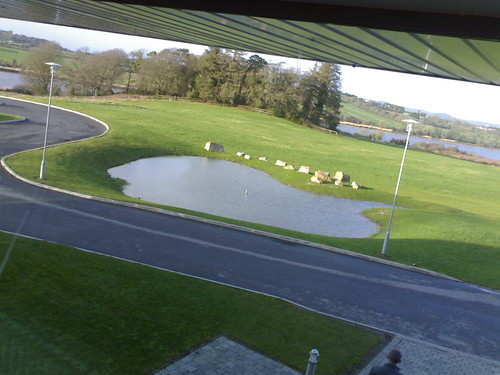
View from Southeast Barcamp on Flickr - Photo Sharing!
Well I am really sorry that I missed an event hosting in my own building BarCamp SouthEast!!!! That's the breaks when schedules don't work out. I was triple booked last Saturday, and with a one year old daughter, family comes first at the weekends.
So sorry to all the cool presenters who came to the TSSG building (or to use the new name the ArcLabs Research & Innovation Centre, that is a abstract concept encompassing the TSSG research guys, and related innovation activities in WIT including the Centre for Entrepreneurship).
I was glad to see that the event had a good web/RSS/Atom presence, and I saw loads of photos of places I recognise, including this one from Bernie Goldbach, here's a list of Photos on Flickr tagged with BarCamp and SouthEast.
16 October 2006
ArcLab Research & Innovation Centre Opens
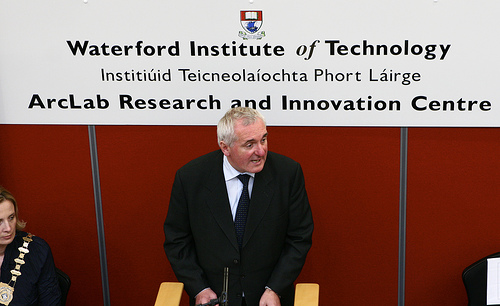
The Taoiseach of Ireland (or prime minister), Bertie Ahern, came to our building in Waterford Institute of Technology's (WIT) new West Campus in Carriganore on Monday 16th Oct to officially open it. The building houses two sets of complimentary activity: (i) the TSSG (Telecommunications Software & Systems Group): a research centre comprising basic research (10 faculty and postdocs, 15 students), applied research (30 researchers) and pre-rpduct development (50 researchers and developers) looking to explore the synergies between these approaches; (ii) the WIT Innovation Centre comprising entrepeneurship programmes such as the SEEPP and managing incubatiuon space in the building for spin-out and spin-in companies.
See Full TSSG Press Release for further details....
7 September 2006
Zinadoo Launch Photo
Here's a snap Paul Watson took as the Zinadoo launch party was starting. I'm there in bottom left as you look with M揵che疝 モ hノigeartaigh (Head of Department, Computing, Mathematics and Physics, WIT) and Paul Barry (Head of School of Science, WIT). This is the atrium area of the IT Building in Waterford Institute of Technology (WIT).30 October 2005
WIT Research & Innovation Building
The TSSG have moved into our new building in Carriganore. A fellow work colleague took this photo and posted it on Flickr so I can cross post easily on my blog.Perhaps the best thing about the building is the site, the views of the River Suir are stunning. I'll post some photos of my own when I get the chance.
28 January 2005
Minister Opens WIT Information Technology Building
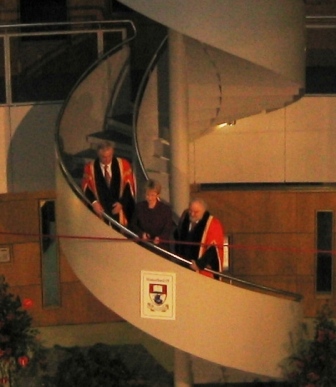
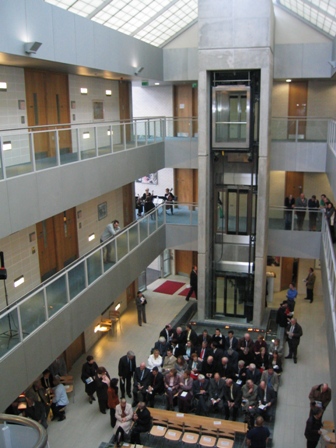
On Friday 28th January 2005 Minister for Education Mary Hannifan opened WIT's new Information Technology building. This shot captures the Minister cutting a ribbon to symbolically open the building.
20 January 2005
TSSG's Research Building Progress
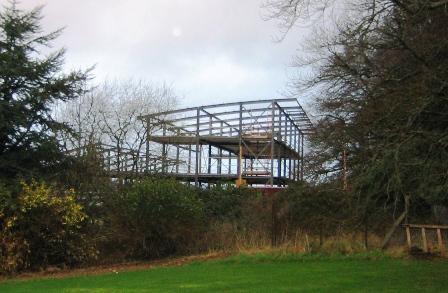
The TSSG won funding from Ireland's Higher Education Authority HEA PRTLI for a research programme called M-Zones (in partnershop with TCD and CIT) and part of this was to fund a research building in WIT. This funding has been combined with Enterprise Ireland funding for an incubation centre for new business to create WIT's Research and Innovation Building. The building is due to open in September 2005, and is progressing well as the photo demonstrates. The building is located in WIT's new Carraiganore site, on the banks of the river Suir.
28 May 2004
TSSG O2 Home of the Future
The TSSG recently demonstrated at eWeek 2004 in Dublin. This demonstration was based on the concept of a Home of the Future. The idea was to build a demonstration from off-the-shelf components available today on the marketplace, and sow how the use of software protocols and middleware can integrate these into a seemless whole. Thus the whole house that was built (made up a kitchen, sitting room, and a dining room and networked devoces in these areas: X10 for lights, and so on coupled with some Inetrnet enabled devices) could be controlled either from local devices (using WiFi) or via mobile phones (potentially anywhere in the world using GPRS). Full details of this demonstration are available at the TSSG O2 Home of the Future website.
This whole concept is merely the front end of the focus of the TSSG research which is on the converged network software that enables these types of services and manages the network. Here a key theme is the development of models of the lower layers so that higher layer functionality can be independent of the actual physical network used to deliver the services, as far as possible. A key requirement is to enable self-managed self-configuring devices and networks, and the current buzz word for this is the "autonomic network".
17 December 2003
20 January 2003
Posting
The recent Netcraft Web Server Survey (Jan 2003) listed a Windows 2000 server as one of the machines (it knew about) on the Internet with the top 50 longest uptimes (the machine was running without a reboot since November 2000).

